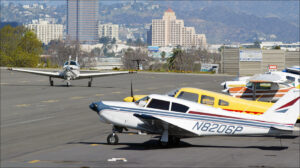
SMO — Flights out of Santa Monica Airport dropped 11 percent in the first half of 2012 compared to the same time last year, and much of the reduction was related to the kinds of local flights that most annoy neighbors, SMO officials told the Airport Commission Monday.
According to statistics released Monday night, flights logged in a category reserved for local operations were 23 percent lower in the first six months of the year compared to the same stretch the year prior.
That category, called by the otherwise cryptic title "local VFR," includes pattern flying, a type of maneuver that requires a student pilot to fly in a box pattern within visual distance of the airport.
Pattern flying is used to practice take-offs and landings, a critical skill for beginning pilots but one that aggravates neighbors who dislike the constant buzz of airplanes flying over the densely-populated area that surrounds SMO and the perceived threat of lead contained in the fuel used to run propeller planes.
Figures showed a 10 percent reduction in operations conducted by propeller planes as well as a 10 percent drop in jet operations, another category of aircraft that draws ire from the local community over pollution concerns and safety issues.
Although there were fewer planes in the sky, noise violations increased by 2 percent and community "inquiries" into flights increased by 17 percent over the same period.
Despite that, community members have noticed an improvement in conditions, although they're uncertain if it's because of cloudy weather during the summer months that could have disrupted flight school traffic or some other reason, said John Fairweather, founder of Community Against Santa Monica Airport Traffic, or CASMAT.
"Alternatively it could be caused by the continuing downward trend in flight school enrollment that has been in effect for a couple of years now due to the economy. Finally there may be a component of the 2012 pattern flying downtick that is actually related to deliberate attempts by flight schools to be less anti-social," Fairweather wrote in an e-mail.
Stelios Makrides, the operations and noise management supervisor at the airport, said he was surprised by the lower numbers when he gathered the information for his statistics, and there's some indication that the same is true at airports across the country.
Employees of an airport in New York reached out to see if SMO had experienced the same slow-down that they had witnessed at their own airport, which mainly handles non-local flights, Makrides said.
The news didn't shock Joe Justice, owner of SMO-based flight school Justice Aviation.
"If the belt gets any tighter, our eyes will pop out," Justice said of the drop off in customers.
The beginning of 2012 has been lean for the flight school, a fact which Justice attributes primarily to the dragging economy, which had mostly spared the Los Angeles flight community until now.
"The L.A. area was kind of a hold out because business was still pretty good," Justice said. "Right after the economic decline, flight schools around the country started dropping like leaves from a tree. It's a labor of love, not profit."
While SMO is left guessing why fewer planes are taking off and landing, airports in the region around Santa Monica aren't.
According to data gathered by the Federal Aviation Administration and compiled by employees of the flight advocacy organization Airplane Owners and Pilots Association, traffic at the Van Nuys Airport is up 5.8 percent, while Palo Alto saw an uptick of over 9 percent in the first six months of 2012.
SMO seems to be an outlier along with Brackett Field in La Verne, Calif., another small airport that saw a 34 percent decrease in traffic, said Katie Pribyl, vice president of communications with aircraft association.
The loss of operations in the beginning of 2012 comes after an increase in almost every category of flights in 2011 compared to 2010.
Total operations increased from 104,950 in 2010 to 110,694 in 2011, or roughly 5.4 percent. It was the first time flight operations has increased over a previous year since 2006.
Those numbers corresponded to a 2.5 percent increase in jet traffic (from 12,853 operations to 13,180) and a 5.5 percent bump in propeller aircraft operations (89,779 to 94,719).
ashley@www.smdp.com









